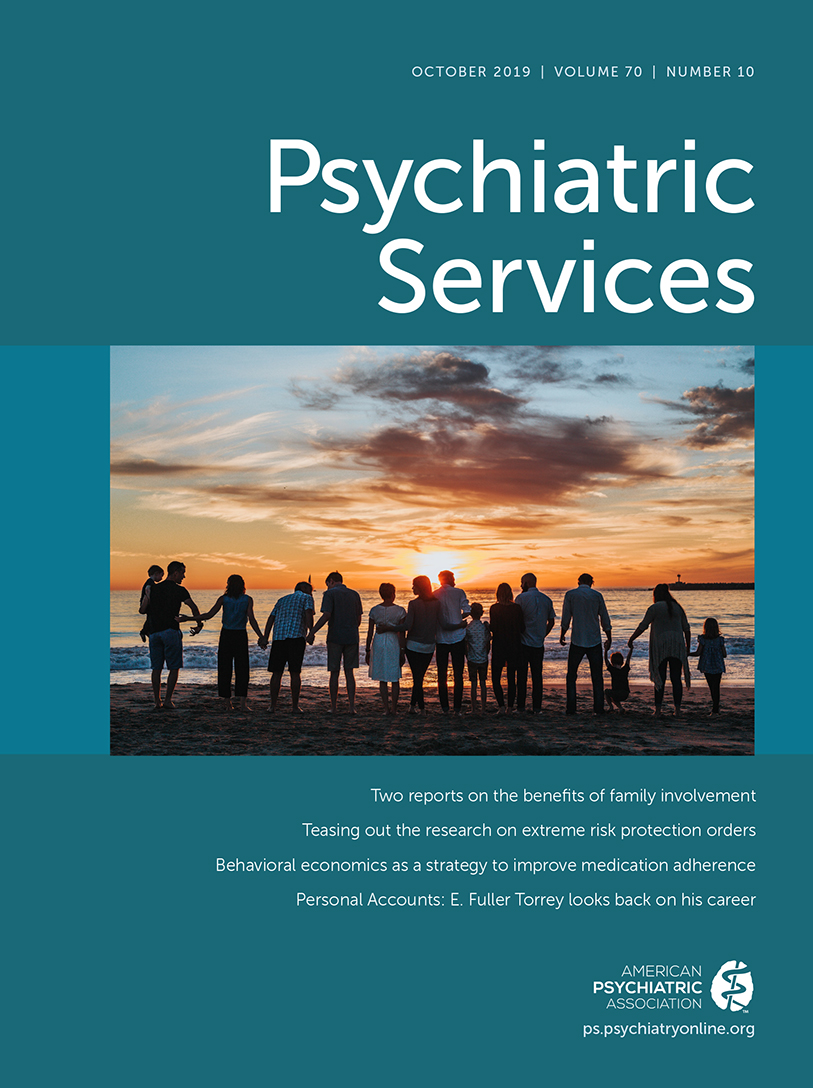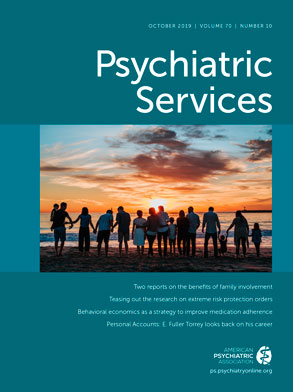Assertive community treatment (ACT), an evidence-based treatment model for individuals diagnosed as having severe mental disorders (
1,
2), has been linked to shorter hospital stays as well as improved quality of life, medication adherence, treatment retention, and patient satisfaction (
1,
2). ACT programs with higher fidelity to the ACT model, typically measured with the Dartmouth ACT Scale (DACTS) (
1,
3), have been shown to be more effective and to have better patient outcomes (
4).
While researchers have examined the clinical efficacy and outcomes of ACT programs (
2) and have studied the national distribution and characteristics of facilities with ACT (
5), less is known about temporal trends in ACT dissemination, fidelity to the model, and service offerings. To address this research gap, we analyzed results from the 2010 and 2016 waves of the National Mental Health Services Survey (N-MHSS). We explored changes in prevalence of ACT programs over time and changes in provision of core ACT services thought to be critical to overall program fidelity as well as secondary services important in addressing the unique needs of individuals with severe mental illness. We also examined the association of state fidelity monitoring with changes in provision of ACT services and in core services.
Methods
Data on facilities offering ACT and the services these programs provided were collected by the Substance Abuse and Mental Health Services Administration (SAMHSA) as part of the N-MHSS, a national survey of all known mental health treatment facilities in the United States, including the District of Columbia (
6). Of the 12,186 eligible facilities in 2010, 11,118 (91.2%) completed the survey and, of these, 9,041 (81% of facilities that completed the survey) reported on provision of ACT. In 2016, of the 13,983 eligible facilities, 12,745 (91.1%) completed the survey and, of these, 12,169 (95.5% of facilities that completed the survey) reported on provision of ACT. In 2016, missing values were imputed by SAMHSA investigators using 2015 data. Because no N-MHSS data existed prior to 2010, we used multiple imputation (
11) to replace missing data for this study, using 20 imputed data sets. Complete case analysis did not differ substantially from the analysis using multiple imputation reported here.
In the N-MHSS survey, ACT was defined as “a multi-disciplinary clinical team approach, [which] helps those with serious mental illness live in the community by providing 24-hour intensive community services in the individual's natural setting” (
6). Similar to a previous study (
5), all facilities that reported offering ACT were included. Services that were examined at facilities reporting provision of ACT included core services approximating those in the DACTS and secondary services addressing the complex needs of individuals with serious mental illness (
7–
9) and were defined similarly to their definitions in prior research (
5). Newly included were facility quality improvement initiatives, continuous education requirements for staff, and discharge outcomes follow-up to assess commitment to quality among facilities reporting provision of ACT.
Data on state fidelity monitoring were collected as part of the SAMHSA’s Uniform Reporting System (URS), which includes data on evidence-based practices and fidelity measurements (
10).
Because both the N-MHSS and the URS are public datasets that do not identify individuals, no institutional review board approval was required for the current study.
We conducted the analyses in two stages, using generalized estimating equations (
11) and linking data by state to address possible clustering. Only services included in both the 2010 and 2016 survey data were used.
First, facilities self-reporting ACT were compared between 2010 and 2016 to assess the number of programs as well as core and secondary service offerings.
Second, we added data from SAMHSA’s URS to our models to examine the association of state fidelity monitoring with changes in the proportion of facilities offering ACT and the proportion of facilities with ACT offering core and secondary services.
We conducted all analyses by using SPSS, version 23, software.
Results
ACT was offered by a smaller proportion of facilities in 2016 than in 2010 (OR=0.73, 95% CI=0.63–0.86, p<0.001) (
Table 1); however, in 2016 a higher proportion of facilities with ACT reported offering all the ACT core services (OR=1.31, p=0.026). The increase was especially pronounced for peer services (OR=1.72, p<0.001) and for integrated co-occurring disorders services (OR=1.23, p=0.004 (
Table 1). Fewer facilities offered case management services in 2016 than in 2010 (OR=0.44, p<0.001).
Regarding secondary services, tobacco cessation (OR=4.53, p<0.001) and telemedicine (OR=2.08, p<0.001) services were more commonly offered in 2016 than in 2010, as was requiring ongoing training for staff (OR=2.32, p<0.001); education services for patients were offered less commonly in 2016 (OR=0.55, p<0.001).
We also tested the interaction terms for ACT and year in the analyses of individual services. The interaction term was significant for provision of integrated co-occurring disorders services and was significant at a trend level for peer services, suggesting a larger increase over time in these services among facilities offering ACT compared with facilities not offering ACT. Interaction terms in analyses of provision of tobacco cessation services, telemedicine, and staff training were not significant, suggesting that the increase in these services at facilities offering ACT was in line with increases in these services at mental health facilities not offering ACT.
The proportion of states that monitored fidelity to the ACT model was 51% (N=26) of 51) in 2010 and 59% (N=30) in 2015. Fidelity monitoring in 2015 was associated with the increase in the proportion of facilities with ACT offering all the core services in 2016 compared with 2010 (adjusted odds ratio [AOR]=1.63, 95% CI=1.29–2.07, p<0.001). Only 5.2% of the temporal variance in proportion of facilities with ACT offering all the core services could be accounted for by state fidelity monitoring in 2015.
Discussion
We found a significant decrease in the proportion of facilities offering ACT from 2010 to 2016. This finding is of concern given previously described findings (
5) demonstrating that in 2015 the national capacity to serve ACT-eligible individuals was just over 40%.
There are likely numerous underlying causes for this decrease. Maintaining funding, which has been linked to ACT dissemination, may be a challenge (
12). Grants, a significant source of ACT funding (
5), tend to run out, affecting long-term sustainability of the programs. Providing sliding scale or free services can also negatively affect program viability in the long term. Maintaining staffing may be difficult for ACT programs (
13). Although there is some evidence that even ACT teams without full staffing may be effective (
14), high staff turnover and prolonged vacancies in key positions inhibit successful team function and patient care (
13). Staffing issues can directly affect program viability in states that link service provision to reimbursement.
Just as important as availability of ACT is program fidelity, which has been linked to improved outcomes (
4). Using self-reported program parameters to approximate the DACTS, we found that the likelihood of offering all the required core ACT services was higher in 2016 compared with 2010. Despite this increase, less than a fifth of facilities self-reporting provision of ACT offered all the required core services. It is plausible, however, that some ACT programs provide services in a way that is not easily measured using the DACTS, for example through the use of telepsychiatry or creative partnerships.
A few explanations are possible for the increase in core services provision. Independent auditing and feedback have been shown to improve fidelity to the ACT model (
15), which is consistent with our findings that state fidelity monitoring explained some of the temporal variance in provision of core services. Additionally, there may be selective attrition favoring programs that provide all the core services in states that link fidelity and funding.
Only a small proportion of the changes in provision of required services could be explained by state fidelity monitoring. Provision of the required ACT services may have been promoted by other means. For example, Veterans Affairs and military facilities are more likely to operate or provide funding for programs that provide all the required ACT services (5). Such facilities may have unique oversight requirements that promote higher fidelity to ACT.
Among the core services offered, there was a significant increase from 2010 to 2016 in the proportion of ACT programs providing peer services. Integrated co-occurring disorders services were more commonly offered by facilities with ACT in 2016 compared with 2010. The increases in these services were significantly more pronounced among facilities providing ACT compared with facilities not providing ACT.
Patients with severe mental illness often have unique and complex needs (
8,
9) and may benefit from secondary services not captured by the DACTS. An example would be tobacco cessation services. The odds of tobacco cessation services being offered by facilities with ACT in 2016 were more than four times higher compared with the odds in 2010. Telemedicine, an alternative way to disseminate the specialized expertise of ACT programs, was also more commonly offered in 2016. Although the findings regarding secondary services generally reflected trends among all facilities offering mental health services, they may be particularly relevant to ACT clients.
We used N-MHSS data from 2010 and 2016 to examine quality improvement initiatives unrelated to ACT fidelity. Our results show that the likelihood of facilities with ACT requiring continuous education for staff in 2016 was more than double that of 2010, mirroring a trend among all mental health treatment facilities. Although the proportion of facilities with ACT that conducted quality review of cases did not change between the two time points, more than 98% of facilities with ACT at both time points implemented such practices. Additionally, more than 60% of facilities providing ACT conducted some form of outcome follow-up at both time points, with no significant change noted over time.
This study’s findings are limited by the following factors. First, the unit of analysis was facility, allowing only indirect examination of individual programs. Some facilities may have housed other programs along with ACT. The true fidelity of ACT programs may thus be lower than reported here. Second, because DACTS scores were not available, services offered at facilities with ACT were examined and used to approximate DACTS scores. Finally, the definition of ACT in the N-MHSS was broader than the classical definition of ACT, possibly affecting the generalizability of our findings to classical ACT programs and overestimating the number of facilities offering ACT.
Conclusions
By examining data from facilities with ACT from 2010 to 2016, this study demonstrated that the national availability of self-identified ACT programs has declined, likely decreasing national capacity to provide ACT-eligible individuals with this evidence-based service. The results show an increase in the proportion of facilities with ACT that offer the full array of required services. The overall proportion of facilities offering all the core services, however, remains low. State fidelity monitoring has contributed to increased fidelity, although this monitoring explained only a small proportion of the temporal variance in fidelity, suggesting there may be other causes. Facilities offering ACT continue to provide important secondary services to their clients and have maintained or increased their focus on measurable quality markers not directly tied to program fidelity. Our findings call for greater attention to dissemination of ACT to prevent further decline in the national capacity to serve a vulnerable patient population as well as to continue efforts to improve program fidelity to the ACT model. Further examination of ACT programs is warranted to better understand trends in the provision of this care.

